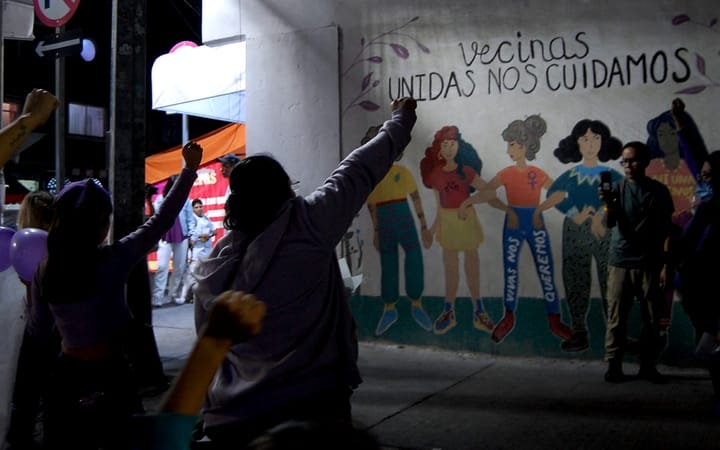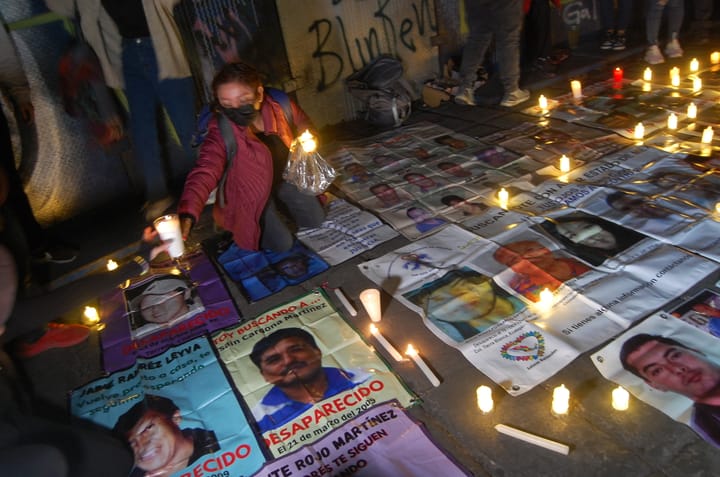Ten days of indifference
The families of the 43 disappeared students from Ayotzinapa came to Mexico City to demand the president fulfill his promises to find their children before he leaves office. One government institution after another turned down their requests for a meeting, until they pushed down the walls themselves.

The families reached Mexico City’s Zócalo at dusk on Monday, February 26, at the end of the march that marked 113 months since their children were disappeared at the hands of the Mexican state. This time, they came to stay. As night fell, they raised the poles of a white tent that would shelter them as they sought a meeting with President Andres Manuel López Obrador. Thus began the ten-day protest of the Committee of Mothers and Fathers of the 43 against “the wall of impunity”: the president’s failure to fulfill the decree, signed in his first days in office, that he would find the 43 disappeared students from the Raul Isidro Burgos teachers’ college in Ayotzinapa, Guerrero.
The next day, they protested outside the Ministry of the Interior, and Wednesday found the families outside the the Senate. Gathered along the gate on Milan Street by the building’s back entrance, they requested an audience with Ricardo Monreal, president of the political coordinator committee, and Martha Micher Camarena, president of the gender equality committee. As they awaited a response, the families and the organizations gathered gave speeches. Representatives from the Otomí community of Santiago Mexquititlán and the CNTE, the teachers’ union, joined them, as well as dozens of current students from Ayotzinapa and other teachers’ colleges.
Two men in suits slipped out the gate for a whispered conversation with the families’ representatives. The Senate would not receive them. To end the protest, the students raised their fists in the air and sang “Venceremos.” Several students uncapped bottles of red and black spray paint and painted slogans—“We're missing 43,” “We want them alive”—across the gates. As the parents boarded the buses back to the Zócalo, the students reached into their backpacks for homemade explosives in PVC pipes. A blast shattered the glass behind the door number four, then another, then another.
Solidarity and fury
Back in the Zócalo, the normalistas rested on mats in the shade. A few young men spray-painted a long strip of butcher paper to make a banner with their demands: turn over the 800 military files that were missing in the previous investigation. Continue all the lines of investigation about the case. Extradite Tomás Zerón de Lucio, the former official of the Criminal Investigation Agency who orchestrated the cover-up of the 43’s disappearance and is now sheltered in Israel. Return of the Interdisciplinary Group of Independent Experts, who left Mexico after they determined that the military was obstructing the investigation. Punishment for those responsible for the crime.
A few dozen supporters joined the families in the Zócalo for an evening of culture in support of their fight. The rap duo La Otra Rima and reggae artist Amenic performed their music over two speakers hooked up to a pickup truck. Across the square, workers set up the equipment for the campaign launch of Claudia Sheinbaum. Every so often, electronic music boomed from the campaign stage, briefly drowning out the musicians’ protest.
Between acts, Don Clemente Rodriguez, father of Christian Rodríguez Telumbre, took the microphone. “We’re not the same as when we started,” he told the small crowd huddled in the chilly evening. “Now we’re furious.”
“The president gets angry when we compare him with the government of Enrique Peña Nieto,” he added, “but they’re the same.”
Closed doors
Thursday’s protest began shortly after 10 a.m. at the back entrance to the Foreign Ministry, where the families demanded a meeting with secretary Alicia Bárcena. Though the families had originally planned to return to Guerrero the following day, they announced that they would maintain the protest in the Zócalo until they received a response from the state.
“We’re not even asking for an immediate meeting, just for the president to give us a date,” said Vidulfo Rosales, the parents’ lawyer, from the Tlachinollan Human Rights Center in Guerrero.
Again the throng of normalistas held up their brightly painted banners; again the families reiterated their demands. They emphasized the extradition of both Tomás Zerón and José Ulises Bernabé, formerly the head of the municipal jail in Iguala. There is evidence that Bernabé held 17 of the 43 disappeared students on the night of September 26, 2014, in Iguala. He is currently in the United States, where he was granted political asylum.
At 1:10PM, the families’ representatives announced that the Foreign Ministry would not receive them. As “Venceremos” rang out over the narrow street, again the students whipped out spray paint and improvised explosives. As the buses advanced, one explosion after another shook the narrow street. Smoke and dust filled the air. Some 15 detonations later, the students and parents were gone.


Silence from the stage
When supporters of Claudia Sheinbaum began to trickle into the Zócalo on Friday, the smell of woodsmoke from the families’ breakfast fire still drifted through the square. The normalistas cordoned off the area around their tent camp. A little before 1pm, a few of them jumped the metal barriers outside the National Palace and scaled the windows. They strung up a hand-painted banner: “we demand dialogue with the president.”

The parents watched the crowd from the shade under the tents. A line of politicians filed onto the stage, among them former Criminal Investigation Agency commissioner Omar García Harfuch, who played a role in the original cover-up of the Ayotzinapa case, now member of Sheinbaum’s campaign team. As the presidential candidate assumed the podium to tepid applause, the mothers peeled chiles and ground them into a salsa. Sheinbaum listed off her policy proposals. Not once did she mention the disappeared. The mothers added kindling to the fire beneath a charcoal-blackened pot of rice.
Persistence
On Monday the families protested outside of the Arraignment House of the public prosecutor’s office. Once again they were denied a meeting. Students commandeered a truck and rammed it into the door, knocking down the metal gate. On Tuesday, the ninth day of protests, the families and students arrived at the Anti-Monument to the 43, at the intersection of Reforma, Bucareli and Juarez avenues, around noon. Their five buses blocked the entrances to the traffic circle, shutting down three of the city center’s most important thoroughfares. The students spray-painted a soda delivery truck. For three hours they reiterated their demands: a meeting with the president. Extradition of Tomás Zerón. The 800 folios. Justice.
On the tenth day, the students attempted to knock down the wall of impunity that they’d come to confront: during the president’s morning press conference, they rammed a truck into the entrance to the National Palace. The president said he would meet with the families within 20 days. That afternoon, the families departed for Guerrero.


